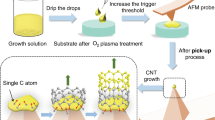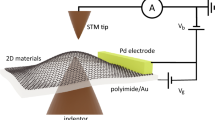Abstract
The effects of mechanical deformation on the electrical properties of carbonnanotubes are of interest given the practical potential of nanotubes in electromechanicaldevices, and they have been studied using both theoretical1,2,3,4and experimental5,6 approaches. One recent experiment6 used the tip of an atomic force microscope (AFM) to manipulate multi-wallednanotubes, revealing that changes in the sample resistance were small unlessthe nanotubes fractured or the metal–tube contacts were perturbed. Butit remains unclear how mechanical deformation affects the intrinsic electricalproperties of nanotubes. Here we report an experimental and theoretical elucidationof the electromechanical characteristics of individual single-walled carbonnanotubes (SWNTs) under local-probe manipulation. We use AFM tips to deflectsuspended SWNTs reversibly, without changing the contact resistance; insitu electrical measurements reveal that the conductance of an SWNT samplecan be reduced by two orders of magnitude when deformed by an AFM tip. Ourtight-binding simulations indicate that this effect is owing to the formationof local sp3 bonds caused by the mechanical pushingaction of the tip.
This is a preview of subscription content, access via your institution
Access options
Subscribe to this journal
Receive 51 print issues and online access
$199.00 per year
only $3.90 per issue
Buy this article
- Purchase on Springer Link
- Instant access to full article PDF
Prices may be subject to local taxes which are calculated during checkout




Similar content being viewed by others
References
Crespi, V., Cohen, M. & Rubio, A. In situ band gap engineering of carbon nanotubes. Phys. Rev. Lett. 79, 2093–2096 (1997).
Kane, C. L. & Mele, E. J. Size, shape, and low energy electronicstructure of carbon nanotubes. Phys. Rev. Lett. 78, 1932–1935 (1997).
Nardelli, M. & Bernholc, J. Mechanical deformations and coherenttransport in carbon nanotubes. Phys. Rev. B, 60, R16338–16341 (1998).
Rochefort, A., Salahub, D. & Avouris, P. The effect of structural distortions on the electronicstructure of carbon nanotubes. Chem. Phys. Lett. 297, 45–50 (1998).
Bezryadin, A., Verschueren, A., Tans, S. & Dekker, C. Multiprobe transport experiments on individual single-wall carbon nanotubes. Phys. Rev. Lett. 80, 4036–4039 (1998).
Paulson, S. et al. In situ resistance measurements of strained carbonnanotubes. Appl. Phys. Lett. 75, 2936–2938 (1999).
Kong, J., Soh, H., Cassell, A., Quate, C. F. & Dai, H. Synthesis of individual single-walled carbon nanotubeson patterned silicon wafers. Nature 395, 878–881 (1998).
Soh, H. et al. Integrated nanotube circuits: controlled growth and ohmic contactingof single-walled carbon nanotubes. Appl. Phys. Lett. 75, 627–629 (1999).
Kong, J. et al. Synthesis, integration and electrical properties of individual single-walledcarbon nanotubes. Appl. Phys. A 69, 305–308 (1999).
Salvetat, J. P. et al. Elastic and shear moduli of single-walled carbon nanotuberopes. Phys. Rev. Lett. 82, 944–947 (1999).
Timoshenko, S. Strength of Materials. Part I, Elementary Theory and Problems (Van Nostrand,New York, 1930).
Walters, D. et al. Elastic strain of freely suspended single-walled carbon nanotuberopes. Appl. Phys. Lett. 74, 3803–3805 (1999).
Hertel, T., Martel, R. & Avouris, P. Manipulation of individual carbon nanotubes and theirinteraction with surfaces. J. Phys. Chem. 102, 910–915 (1998).
Jayanthi, C. S. et al. Order-N method for a nonorthogonal tight-binding Hamiltonian. Phys. Rev. B 57, 3799–3802 (1998).
Datta, S. Electronic Transport in Mesoscopic Systems. (University Press, Cambridge, 1995).
Wu, S. Y. & Jayanthi, C. S. Local analysis via the realspace greens function method. J. Modern Phys. B 9, 1869–1897 (1995).
Alfonso, D., Wu, S. Y., Jayanthi, C. S. & Kaxiras, E. Linking chemical reactivity, magic numbers, and local electronic propertiesof clusters. Phys. Rev. B 59, 7745–7750 (1999).
Rochefort, A., Lesage, F., Salhub, D. & Avouris, P. Conductance ofdistorted carbon nanotubes. Phys. Rev. B. 60, 13824–13830 (1999).
Kim, P. & Lieber, C. Nanotube nanotweezers. Science 286, 2148–2150 (1999).
Acknowledgements
We thank C. Quate for discussions and use of equipment. This work was supportedby the Defense Advanced Research Projects Agency/Office of Naval Research,National Science Foundation, Semiconductor Research Corporation/Motorola,a David and Lucile Packard Fellowship, a Terman Fellowship, the Laboratoryfor Advance Materials at Stanford, National Nanofabrication Users Networkat Stanford, the Camile Henry-Dreyfus Foundation, the American Chemical Societyand the University of Kentucky Center for Computer Sciences.
Author information
Authors and Affiliations
Corresponding author
Rights and permissions
About this article
Cite this article
Tombler, T., Zhou, C., Alexseyev, L. et al. Reversible electromechanical characteristics of carbon nanotubes underlocal-probe manipulation. Nature 405, 769–772 (2000). https://doi.org/10.1038/35015519
Received:
Accepted:
Issue Date:
DOI: https://doi.org/10.1038/35015519
This article is cited by
-
Emerging Internet of Things driven carbon nanotubes-based devices
Nano Research (2022)
-
Investigation of vibrational manner of carbon nanotubes in the vicinity of ultrasonic argon flow using molecular dynamics simulation
Scientific Reports (2021)
-
Numerical prediction of elastic properties for carbon nanotubes reinforced composites using a multi-scale method
Engineering with Computers (2021)
-
Analysis of quantum effects of fine scaling on the axial buckling of MWCNTs based on the density functional theory and molecular mechanics method
Applied Physics A (2021)
-
Carbon nanotube embedded adhesives for real-time monitoring of adhesion failure in high performance adhesively bonded joints
Scientific Reports (2020)
Comments
By submitting a comment you agree to abide by our Terms and Community Guidelines. If you find something abusive or that does not comply with our terms or guidelines please flag it as inappropriate.



